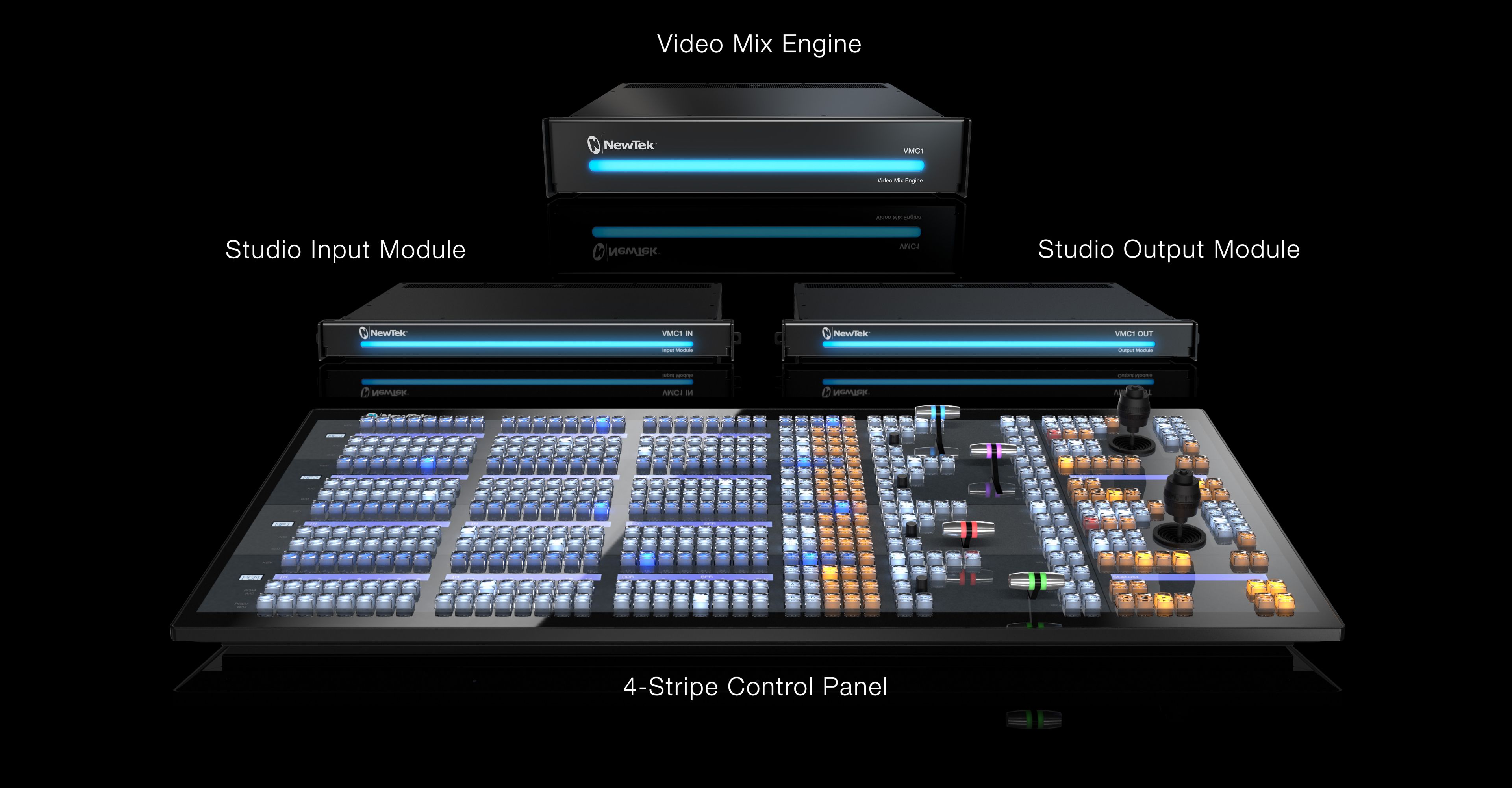
Today NewTek introduced its IP Series, a software-based, modular audio/video production system with virtually limitless access to sources and mixing options. I am also delighted to see NewTek’s improved documentation of non-integer framerates in this new series, which I’ll cover ahead in this article. To my knowledge, the NewTek IP Series is the first very large production system designed for IP audio/video, while also retaining backward compatibility with optional SDI for connection to legacy devices. For that, NewTek’s IP Series uses separate, scalable components for the mixing and control, input, and optional output of sources allowing virtually unlimited scalability. As we could have easily predicted, video, audio, and control signals from these components are transferred digitally using NewTek’s open NDI (Network Device Interface) technology (which I covered last year, and called it the new lingua franca of independent broadcast brands) allowing multiple video systems to identify and communicate with any other system over a standard IP network.
Best of two possible worlds
Considering that the NewTek IP Series works with standard, commercial-off-the-shelf network infrastructure products, i.e. Ethernet cable, connectors and switches, when creating a new system or expanding an existing one, you can take advantage of both current and future offerings of such commodities. You can use NewTek’s established live production software, and if and when necessary, connect to your existing SDI-based legacy devices.
Current modules in the IP Series
The nucleus of the NewTek IP Series is the NewTek VMC1 Video Mix Engine (shown at the top of the photo below), which is capable of switching or mixing among up to 64 source channels, including 44 external inputs (each with key and fill) and full mixing control with 8 M/Es with full re-entry. As of publication time of this article, it is not clear whether NewTek intentionally chose to offer a palindromic number of external inputs, but for a palindromic lover like me who even has a radio show whose name —CapicúaFM— translates to English as palindrome, it certainly stands out, even if you really don’t need 44 simultaneous sources, and could perhaps get by with only 33, 22 or 11 simultaneous sources. Of course, you could also use a non-palindromic amount of sources too.

Each VMC1 Video Mix Engine includes integrated compositing, a macro automation engine, and a scalable effects system with nearly unlimited matting, DVE, transitions, overlays, virtual sets and real-time data. Multiple NewTek VMC1 Video Mix Engines can be placed on the network, allowing for both expansion and/or complete redundancy as needed.
The VMC1 4S Control Panel (shown at the bottom of the above picture) allows the operator to manage a single or multiple engines.
The VMC1 IN Studio Input Module (shown in the mid left of the above photo) allows up to 4 SDI or IP inputs per module recognized by the VMC1 Video Mix Engine. Modules can be added at any location on the network to increase camera/source count as necessary. Each module includes a multiviewer (see main photo at the top of this article) with return video feed and ISO recording capability to network storage.
The VMC1 OUT Studio Output Module (shown in the mid right of the above photo) is a 4 channel multi-format modular video delivery hub that can reside anywhere on a network.
Improved documentation of non-integer framerates
After NewTek improved the waveform monitor display in its TriCaster series (illustrated above, covered in this article and in this white paper), my only remaining complaint has been that NewTek continues to round non-integer framerates to the closest integer in its TriCaster line of products, both in the documentation and in onscreen menus. As I have covered in past articles, rounding them to the closest integer is confusing and can cause both users —and even other manufacturers (i.e. Canon with the first firmware of the 5D Mark II) and software developers— to take them literally and cause havoc in the video production community. Non-integer framerates should be expressed to two decimal points (even though the actual number is much longer) in the cases of 29.97 and 59.94, and preferably to three decimals in the particular case of 23.976 although some manufacturers sadly shorten 23.976 to “23.98”.
I am thrilled to see that NewTek has corrected this dangerous practice both with its TalkShow product (illustrated above, covered in Part III of this article) and now with the IP Series, although to two decimals. In the published tech specs, the VMC1 IN Studio Input Module can handle any of the following framerates via 3G-SDI:
- 1080p59.94, 1080p50 exact (primarily for PAL and ex-PAL regions), 1080p29.97, 1080p25 exact (primarily for PAL and ex-PAL regions), 1080p24 exact, 1080p23.976 (rounded by NewTek to 23.98)
- 1080i59.94, 1080i50 exact (primarily for PAL and ex-PAL regions)
- 720p59.94, 720p50 exact (primarily for PAL and ex-PAL regions), 720p29.97, 720p25 exact (primarily for PAL and ex-PAL regions), 720p24 exact, 720p23.976 (rounded by NewTek to 23.98)
• 576i50 exact (aka 576i25) (primarily for PAL regions)
• 480i59.94 (aka 480i29.97)
Many camera manufacturers have made the same correction/improvement in their latest models, including in the consumer line of their products. I truly hope that in the near future, NewTek will make this same vital correction/improvement to to the documentation and menu settings of its TriCaster products as well, perhaps when it offers its next software update. If and when that happens, you’ll hear from me about it, so we’ll be able to celebrate it together.
Availability of the NewTek IP Series
The VMC1 Video Mix Engine, VMC1 4S 4-Stripe Control Panel, and the VMC1 IN Studio Input Module are available immediately. The NewTek VMC1 OUT Studio Output Module will be available in Q4 2016. When I asked NewTek during a briefing last week, the company confirmed that these products will be available both directly to broadcasters, as well as via its worldwide authorized dealer network. So contact NewTek or your authorized NewTek dealer for pricing in your area.
Upcoming articles, reviews, radio shows, books and seminars/webinars
Stand by for upcoming articles, reviews, and books. Sign up to my free mailing list by clicking here.
Si deseas suscribirte a mi lista en castellano, visita aquí. Si prefieres, puedes suscribirte a ambas listas (castellano e inglés).
Listen to his CapicúaFM show at CapicúaFM.com in iTunes or Stitcher.
FTC disclosure
No manufacturer is specifically paying Allan Tépper or TecnoTur LLC to write this article or the mentioned books. Some of the other manufacturers listed above have contracted Tépper and/or TecnoTur LLC to carry out consulting and/or translations/localizations/transcreations. Many of the manufacturers listed above have sent Allan Tépper review units. So far, none of the manufacturers listed above is/are sponsors of the TecnoTur programs, although they are welcome to do so, and some are, may be (or may have been) sponsors of ProVideo Coalition magazine. Some links to third parties listed in this article and/or on this web page may indirectly benefit TecnoTur LLC via affiliate programs.
Copyright and use of this article
The articles contained in the TecnoTur channel in ProVideo Coalition magazine are copyright Allan Tépper/TecnoTur LLC, except where otherwise attributed. Unauthorized use is prohibited without prior approval, except for short quotes which link back to this page, which are encouraged!

